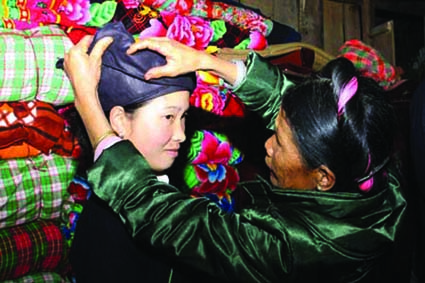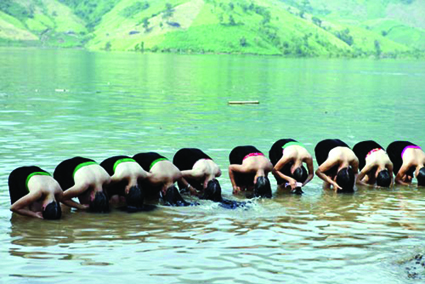>>Farming rituals of the Kho Mu
Ta Thi Tam
Ethnology Institute
Wedding of the Kho Mu, a Mon-Khmer language group living in the northern and central parts of the country with a population of nearly 73,000, reflects the group’s original culture.

A Kho Mu wedding goes through four rituals, namely engagement, wedding, matrilocal residence and bridal escort.
At the age of 15, Kho Mu boys start dating with their girlfriends. To flirt a girl, a Kho Mu boy will play dan nhi, a sort of vertical violin with two strings, a long handle and a sound box played with a bow, under her stilt-house every evening. If he wins her heart, she will go outside and chat with him till the dead of night.
When his girlfriend agrees to marry him, the boy will ask his parents to visit her family to make a marriage proposal. The party of the boy’s family, including an uncle of the boy as the head, his parents and some cousins, brings to the girl’s family betel and areca, four liters of wine, two kilos of rice and two chickens as the proposal offerings.
The boy’s family is warmly welcomed by the girl’s parents who will ask for their daughter’s opinion before accepting the proposal made by the boy’s uncle on behalf of his family.
The two families then have a meal together to mark their engagement. This meal is made by the girl’s family from all the proposal offerings. During the meal, the families discuss about the wedding presents.
A month after the proposal ceremony, the boy’s family chooses a good date for the wedding.
On the wedding day, the groom’s family gives wedding presents as exacted by the bride’s, which usually include a pig, four chickens, 30 kilos of rice, 60 liters of wine, two silver coins, two sets of cushions and quilts, a necklace, a pair of bracelets, a pair of earrings, a brooch, a pair of headdresses, a belt, a new dress and a new shirt. A representative of the bridal family receives the bridal presents in the presence of the village head as the witness of the two families’ engagement.
With the pig and chickens offered to the bride’s family, the groom’s makes a meal for offering to the bride’s ancestors. The offering ritual is conducted at the altar of the girl’s family, which is a square bamboo wattle placed in the middle of the worship section - the first part of the house next to the stairway reserved for guests. The offerings are put on the wattle with members of the bridal family and the groom sitting around. The bride’s father as ritual conductor informs the family’s ancestors of the groom as a new family member, inviting them to the wedding and praying for their support for the new couple’s happiness. After praying, he pastes sticky rice onto the hair of the groom and other family members and applies chicken blood to their knees. Closing the ritual, everyone sitting around the altar eats some food from the offering tray before joining their relatives and villagers in a wedding feast which lasts all day long.
A month after the wedding, the bride’s family gives each member of the groom’s family a present which is a pieu scarf, an embroidered brocade headdress. They also present the groom’s father a set of indigo clothes.
After the wedding, the groom must stay with his wife’s family between one and three years. In the past, this stay might last as long as twelve years during which the son-in-law will bear his wife’s family name. Nowadays, a groom does not have to change his family name and can give money and food to his parents-in-law to shorten his matrilocal stay.
When the matrilocal period ends, the parents-in-law must give their son-in-law all the things needed for a new family, including cushions, quilts, rice seeds, breeder pigs, farming tools, and even buffalos and cows if the bride’s family is well-off.
To take their bride home, the groom’s parents must bring gifts to her family again, which comprise a pig, ten chickens, 100 liters of wine, 50 kilos of rice and 1 kilo of salt. The bride’s family will weigh these offerings to see if they are sufficient.

The party taking the bride to her husband’s includes the groom’s parents, uncles, aunts and brothers. With the offerings, the groom’s family again prepares a meal for offering to the bride’s ancestors, asking for their permission for the couple to leave the bride’s home. After the offering ritual, the two families and villagers of the bride have a farewell party.
The bridal family’s party escorting the bride home, which includes the bride’s uncles, aunts and cousins, attends an offering ritual at the groom’s home similar to that conducted at the bride’s on the wedding day. The groom’s family members together with the bridal party sit around the offering tray. The host of the groom’s family mixes chicken eggs with sticky rice, pastes them onto the hair of the bride and other family members and applies chicken blood to their knees. This ritual aims to ask the groom’s ancestors to accept their new daughter-in-law and pray for their support for good health, happiness and prosperity for the new couple. After the offering ritual, the two families and villagers have a feast which costs the groom’s family a pig, six chickens, 30 kilos of rice and 60 liters of wine.
The daughter-in-law takes charge of the housework, including cooking, taking care of animals and preparing beds for family members. She is not supposed to have meals together with her father-in-law or to enter the room of her parents-in-law.-


